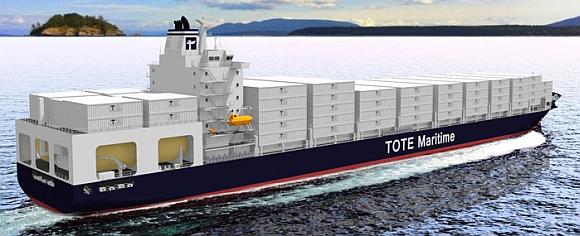 In December, Totem Ocean Transport Express (TOTE) ordered two new LNG powered container ships from NASSCO shipyard in San Diego. Late last month they also signed a contract with NASSCO to convert two existing roll-on/roll-off ships to LNG fuel. These ships will be the largest ships in the world powered primarily by Liquefied Natural Gas (LNG). The contracts raise the question – is LNG the fuel of the future for shipping?
In December, Totem Ocean Transport Express (TOTE) ordered two new LNG powered container ships from NASSCO shipyard in San Diego. Late last month they also signed a contract with NASSCO to convert two existing roll-on/roll-off ships to LNG fuel. These ships will be the largest ships in the world powered primarily by Liquefied Natural Gas (LNG). The contracts raise the question – is LNG the fuel of the future for shipping?
For roughly the past hundred years, since shifting over from coal, most ships have burned “residual fuel.” Known by various names; 6 Oil, Bunker C, and heavy oil; it is dirty and cheap. Well, over the past few years, it has no longer been as cheap but it has gotten no cleaner. A few years ago, a headline appeared in US and international newspapers – “How 16 ships create as much pollution as all the cars in the world.” The headline was an overstatement but was accurate in at least one regard – residual fuel is very dirty and ships that burn residual fuel produce a lot of sulfur dioxide and particulate pollution.
Natural gas, by comparison, is relatively clean. For the same amount of energy, when burned it releases about 5% of the particulates, 30% of the sulfur dioxide, 35% of the nitrates and around 65% of the CO2. Natural gas is the “cleanest” of all fossil fuels available today, which is why so many power plants have shifted from coal and residual fuel to natural gas. Natural gas is also currently about 70% cheaper than residual fuel.
The problem with natural gas is that it is not easy to transport except by pipeline. If turned into a liquid it is 600 times more dense and can be carried in insulated tanks. The tanks need to be insulated because the only way to liquefy natural gas is to refrigerate it to -160 C or -270F. Due to the difficulties in handling, storing and supplying the super-cold fuel, there are fewer than 50 vessels in-service or on order world-wide that operate on natural gas. The majority of these are car and passenger ferries and virtually all of them operate in Norway or the Baltic or North Sea. For TOTE to order four LNG powered ships is a huge step forward for the adoption of LNG as shipboard fuel.

Just in case one of the systems, or the logistics just don’t work out:
Dual Fuels: Natural Gas, and Diseasel are the only way to go.
Remember the NS Savannah, how did that work out for them?